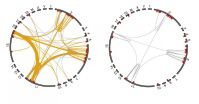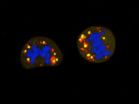Come here and be quiet!
Genes physically held in silencing 'lock-down' in embryonic stem cells
2015-08-31
(Press-News.org) Researchers at the Babraham Institute have discovered a strong physical gene interaction network that is responsible for holding genes in a silencing grip during early development. In the same way that people can interact with others in close proximity, say within the same room, or others millions of miles apart, there are also short- and long-range interactions within the genome forming a three-dimensional configuration where different parts of the genome come into contact with each other. The research, reported online in Nature Genetics, presents how key decision-making genes which specify the embryo's blueprint for subsequent development are physically clustered in the nucleus of embryonic stem cells and maintained in a silent state.
The different cell types forming an embryo are derived from embryonic stem cells (ESCs). These cells are self-renewing and are maintained in an undifferentiated state meaning that they have the potential to become any cell type in the body. To become a specific cell type, embryonic stem cells progress along a developmental pathway, losing their stem cell characteristics and gaining new features. At a genomic level, assuming a specialised cellular identity reflects the switching on of appropriate developmental genes. Conversely, maintaining a stem cell identity requires the repression of developmental genes.
Using a novel technique developed at the Babraham Institute (Promoter Capture Hi-C), the researchers identified an unusually strong 3D network of developmental genes in ESCs. These genes encode proteins that establish the embryo's body plan and direct organ development. As an ESC, you don't want these instructions being read at this stage and so to prevent this, the genes are clustered together and silenced. The research showed that at the heart of this repression is a protein complex called Polycomb repressive complex (PRC1), a master regulator of ESC genome architecture. The research therefore establishes a mechanism, acting by physical interaction between specific genes and PRC1, which effectively holds genes in a silenced state. This prevents their expression in ESCs and so ensures maintenance of the undifferentiated state.
The researchers propose that the selective release of genes from this network leads to their expression and thus controls early development decisions that start the stem cell along the road to becoming a defined cell type. Lastly, de-regulation of Polycomb complexes has been shown to be the cause of several cancers and developmental disorders emphasising the importance of understanding Polycomb-mediated gene repression in development and disease.
Dr Sarah Elderkin, Group Leader in the Institute's Nuclear Dynamics research programme and lead author on the Nature Genetics paper said: "Analysing the genome-wide connections of 22,225 promoters in the genome of mouse embryonic stem cells allowed us to identify a sub-set of nearly 100 promoters which form the strongest interaction network seen in the entire genome. This is exciting because the members of this sub-set encode early developmental regulators which define what the embryonic stem cell will become. This research uncovers a mechanism for how inappropriate expression of developmental genes is prevented and also suggests how genes are freed from this silencing in order for normal embryonic development to proceed."
INFORMATION:
Funding support for this research was provided by the Wellcome Trust to Dr Sarah Elderkin, Medical Research Council (MRC) to Dr Peter Fraser and the European Commission to Dr Nicholas Luscombe as part of the FP7 EpiGeneSys Network of Excellence. The Babraham Institute is strategically funded by the Biotechnology and Biological Sciences Research Council (BBSRC).
[Attachments] See images for this press release:


ELSE PRESS RELEASES FROM THIS DATE:
2015-08-31
Outpatient human immunodeficiency virus (HIV) health care facilities funded by the federal Ryan White HIV/AIDS Program (RWHAP) were more likely to provide case management, mental health, substance abuse and other support services than those facilities not funded by the program, according to an article published online by JAMA Internal Medicine.
RWHAP was established in 1990 to provide funds to states, metropolitan areas and clinics to increase access to high-quality HIV care and treatment for low-income, uninsured and underinsured individuals and families affected by ...
2015-08-31
Religious or spiritual considerations were discussed in 16 percent of family meetings in intensive care units and health care professionals only rarely explored the patient's or family's religious or spiritual ideas, according to an article published online by JAMA Internal Medicine.
Understanding how frequently discussions of spiritual concerns take place - and what characterizes them - is a first step toward clarity regarding best practices of responding to spiritual concerns in advanced illness.
Douglas B. White, M.D., M.A.S., of the University of Pittsburgh School ...
2015-08-31
Women with multiple sclerosis (MS) who intended to breastfeed their infants exclusively for two months had a lower risk of relapse during the first six months after giving birth compared with women who did not breastfeed exclusively , according to an article published online by JAMA Neurology.
About 20 percent to 30 percent of women with MS experience a relapse within the first three to four months after giving birth and there are no interventions for effective prevention of postpartum relapse. The effect of exclusive breastfeeding on postpartum risk of MS relapse is ...
2015-08-31
It was long believed that acquired immunity--a type of immunity mediated by T- and B-cells--had memory, meaning that it could learn from new pathogens, making subsequent reactions more effective, whereas innate immunity--which is mediated by macrophages and other types of cells that react to certain molecules typically associated with pathogens--did not. However, it gradually became clear that things were not so simple. Plants and insects, which only have innate immunity, also seem to have immunological memory. Further, it has been reported that herpes virus infection increases ...
2015-08-31
By changing the mouse model they use to study how the immune system responds to cancer, a team of researchers hopes to shift the focus for one emerging form of cancer immunotherapy back to the standard approach--relying on antigen-presenting dendritic cells--and away from the current upstart, macrophages.
Although macrophages, like dendritic cells, also take up antigens, they are more likely to degrade them than present them to T cells. The recent emphasis on macrophages stems, in part, from promising, but problematic, efforts to develop an effective macrophage-driven ...
2015-08-31
Cancer cells become addicted to glucose, which they use as their regular source of energy to grow and develop. Although this was observed over nine decades ago by the German physiologist, Otto Warburg; there is still not therapeutic strategy today that can effectively take advantage of this special energy requirement. The initial approach appears to be simple: the lack of glucose could specifically induce the death of cancer cells.
A new study by the Spanish National Cancer Research Centre Cell and Cancer Unit, headed by the Cell Division and Cancer group of the Spanish ...
2015-08-31
A UCSF-led team has developed a technique to build tiny models of human tissues, called organoids, more precisely than ever before using a process that turns human cells into a biological equivalent of LEGO bricks. These mini-tissues in a dish can be used to study how particular structural features of tissue affect normal growth or go awry in cancer. They could be used for therapeutic drug screening and to help teach researchers how to grow whole human organs.
The new technique -- called DNA Programmed Assembly of Cells (DPAC) and reported in the journal Nature Methods ...
2015-08-31
Scientists from the D'Or Institute of Research and Education (IDOR), the Federal University of Rio de Janeiro (UFRJ) and the Yale University School of Medicine have elucidated the chemical process behind a mysterious gastrointestinal disease that is becoming more frequent every day: the eosinophilic esophagitis (EoE), also known as the "asthma of the esophagus". The researchers identified a molecule which plays a key role in this condition and that can be a target in a new therapeutic strategy.
The eosinophilic esophagitis is a chronic inflammatory disorder of the esophagus. ...
2015-08-31
While the French High Council for Public Health (HCSP) made public on Monday, 24 August 2015, a positive opinion regarding the relevance of the 5-colour code for the public, a team of researchers (Inserm/INRA/Paris 13 University) directed by Serge Hercberg, on publication of their article in the journal Nutrients, demonstrated that the 5-colour nutrition label (5-CNL) is the most effective nutritional information system for allowing consumers to recognise and compare the nutritional quality of foods, including "at-risk" populations (older subjects, those with a lower educational ...
2015-08-31
Amsterdam, NL, August 31, 2015 -- Every week in the U.S. an average of 645 people lose their lives to firearm violence and 1,565 more are treated in an emergency department for a firearm-related injury. Most of these events do not make headlines, but they account for about 7% of the premature deaths before age 65 in the U.S. In a special issue of Preventive Medicine, preventive medicine and health policy experts address a wide range of critical topics related to firearm violence, from the interaction of alcohol abuse with gun violence, effects of changes to gun laws in ...
LAST 30 PRESS RELEASES:
[Press-News.org] Come here and be quiet!
Genes physically held in silencing 'lock-down' in embryonic stem cells


